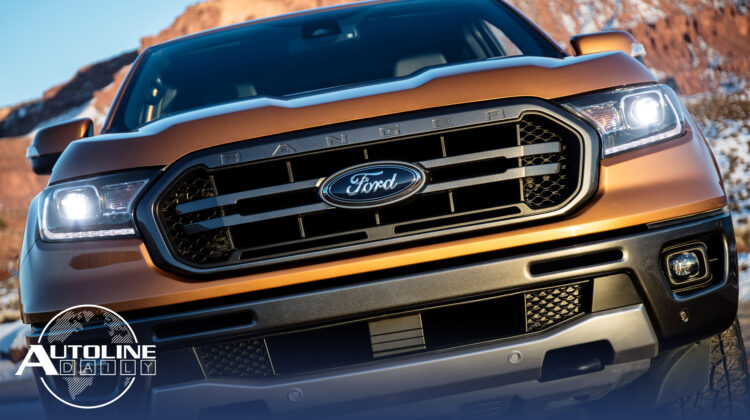
Follow us on social media:
Runtime: 7:56
0:28 Hyundai Names Non-Korean Head Of R&D
1:03 Tesla’s Hold Their Value Better
2:11 New Vehicle Payments Hit All-Time High
3:19 Future Interior Technology
4:37 China to Reduce Tariffs on U.S. Built Vehicles
5:47 U.S. Ranger Different Than Global Version
6:46 Millennials to Carry on Classic Car Tradition
Visit our sponsors to thank them for their support of Autoline Daily: Bridgestone , Dow Automotive Systems , Lear Corporation , and ExxonMobil.
On today’s show…Tesla’s hold their value better than gas cars…China is reducing its import tariff on U.S. built vehicles…and a look at the difference between the U.S. Ranger and the global version. All that and more coming right up on Autoline Daily.
This is Autoline Daily the voice of the automotive industry.
HYUNDAI NAMES NON-KOREAN HEAD OF R&D
In an effort to reverse falling profits and slow sales in key markets, like the U.S. and China, the Hyundai Group announced a major management shakeup. It reassigned 17 top executives across the Group but the most important was Group President, Albert Biermann, being named the head of Research and Development. It’s the first time a non-Korean has held that position, something we’re seeing more of from the automotive group. Biermann, who worked at BMW before joining Hyundai in 2015, is responsible for the launch of Hyundai’s performance N brand.
TESLA’S HOLD THEIR VALUE BETTER
According to a new study from Autolist.com, the Tesla Model S and X hold their value better than any of their gas-powered counterparts. Based on vehicle listings from January 2012 through November of this year, a Model S with 50,000 miles declined, on average, 27% from its original price. It compared that to the Audi A8, BMW 7 Series, Jaguar XJ, Lexus LS, Mercedes S-Class and Porsche Panamera. And its closest competition is the Mercedes S-Class, which declined an average of 33% with the same number of miles. The Jaguar fared the worst, losing an average of 45% of its value. As for the Model X, the average example with 50,000 miles lost 23% of its value compared to the original price. Declining an average of 34%, the Lincoln Navigator was its next closest competition. But it just goes to show that demand for Tesla’s continues to remain high.
NEW VEHICLE PAYMENTS HIT ALL-TIME HIGH
And speaking of vehicle prices, they keep going up. And according to Experian, the average monthly new vehicle payment just reached an all-time high in the U.S. Customers are spending an average of $530 a month for that shiny new car in their driveway. This is driving many people to look at the used car market, including the most attractive customers. Prime and super-prime borrowers now make up more than 50% of the used market. And while the gap between new and used monthly payments continues to widen, the average used car payment also reached a record high at $381 a month.
Coming up next, 4-way headrests and seats that don’t have a front or back.
FUTURE INTERIOR TECHNOLOGY
Yesterday we looked at Magna’s vision for a flexible vehicle interior and here’s some of the technology associated with it that we found interesting. A headrest that’s able to adjust 4 different ways is aimed at improving passenger comfort and sleep support. And for trips where you’re going to be sitting for long periods of time, a seat massage function that vibrates will help keep blood flowing in your limbs. There’s also a mobile app to allow people to do a number of things. If you’re using it for that Cargo mode we reported on yesterday and already know what you’re going to be putting in the car, you use the app to pre-configure the seats. In a ride-sharing scenario, you could check what seats are available before ever getting in the car. Like an airplane, I would imagine people will prefer the window and aisle seats. The app could also let you know if you left something in the seat, like a briefcase. But I’ve got to say the technology Magna is working on that intrigued me the most is a seat back that’s able to slide along the bottom cushion. I find it interesting that the seat would have no true front or back. It makes me wonder, if Magna could make it so small children wouldn’t need a booster seat because the seatbelt would have to be attached to the seat and likely also be adjustable?
CHINA TO REDUCE TARIFFS ON U.S. BUILT VEHICLES
Good news may be coming for automakers that ship vehicles built in the U.S. to China. We have reported previously that China raised import tariffs on U.S. built vehicles in retaliation to tariffs the U.S. imposed on Chinese goods. According to Bloomberg, White House officials told automakers yesterday that the Trump administration believes China will cut the tariffs on vehicles from 40% down to 15%. And while nothing is final yet, the news sent the stock price of a number of automakers up. Shares at Ford and GM rose about 2%, and BMW, Daimler and Volkswagen went up between 2.3% and 4%. Now the two sides will start new talks aimed at ending the trade war.
The new U.S. Ford Ranger is much different than the one sold in global markets. More on that, right after this.
U.S. RANGER DIFFERENT THAN GLOBAL VERSION
Ford sells the Ranger pickup in countries all over the world. But the one it’s selling in the U.S. is completely different, even though it looks exactly the same. So why is that? Well, since it had to duplicate the tooling to make it in the U.S., Ford ended up changing almost every part of the truck. Some parts were changed to meet U.S. safety standards, other parts were changed to meet the specific needs of North American customers. The engine, the drivetrain, the interior, the suspension and even the sheet metal, were all changed or modified. But Ford decided to keep the styling the same because it didn’t want to change the hardpoints of the design. That made engineering the new truck a lot easier. It also made it easy to take lessons learned from assembly plants in Thailand, Argentina and South Africa which make the Ranger, and apply them to the plant in Michigan that makes the U.S. version. Like the old saying goes, what’s old is new.
MILLENNIALS TO CARRY ON CLASSIC CAR TRADITION
If you go to a classic car show you will likely hear someone that’s worried about younger generations carrying the tradition on, but they shouldn’t be. According to Hagerty, for the first time ever, Gen Xers and millennials are looking for vehicle values and classic car insurance quotes more often than baby boomers and pre-boomers. The split is now 53% to 47%. And Hagerty adds, that within 5 years, millennials will be the hobby’s single largest group. What’s even more promising is that requests for values and quotes from all generations are up 17 percent in 2018 over last year. It goes to show the love for classic cars isn’t going away and car shows will be around for a long time to come.
That’s all for today. We’ll be right back here again tomorrow.
Thanks to our partner for embedding Autoline Daily on its website: WardsAuto.com

John McElroy is an influential thought leader in the automotive industry. He is a journalist, lecturer, commentator and entrepreneur. He created “Autoline Daily,” the first industry webcast of industry news and analysis.





